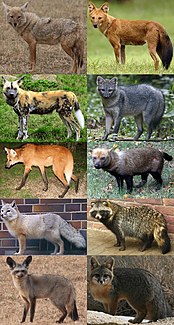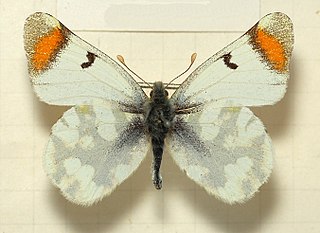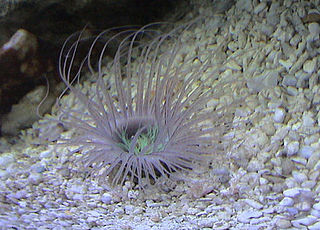
The Abencerrages were a family or faction that is said to have held a prominent position in the Kingdom of Granada in the 15th century.

The biological family Canidae is a lineage of carnivorans that includes domestic dogs, wolves, coyotes, foxes, jackals, dingoes, and many other extant and extinct dog-like mammals. A member of this family is called a canid.

Eagle is the common name for many large birds of prey of the family Accipitridae. Eagles belong to several groups of genera, not all of which are closely related. Most of the 60 species of eagle are from Eurasia and Africa. Outside this area, just 14 species can be found—2 in North America, 9 in Central and South America, and 3 in Australia.
Binomial nomenclature, also called binominal nomenclature or binary nomenclature, is a formal system of naming species of living things by giving each a name composed of two parts, both of which use Latin grammatical forms, although they can be based on words from other languages. Such a name is called a binomial name, a binomen, binominal name or a scientific name; more informally it is also called a Latin name. The first part of the name – the generic name – identifies the genus to which the species belongs, while the second part – the specific name or specific epithet – identifies the species within the genus. For example, humans belong to the genus Homo and within this genus to the species Homo sapiens. Tyrannosaurus rex is probably the most widely known binomial. The formal introduction of this system of naming species is credited to Carl Linnaeus, effectively beginning with his work Species Plantarum in 1753. But Gaspard Bauhin, in as early as 1623, had introduced in his book Pinax theatri botanici many names of genera that were later adopted by Linnaeus.

Anseriformes is an order of birds that comprise about 180 living species in three families: Anhimidae, Anseranatidae, and Anatidae, the largest family, which includes over 170 species of waterfowl, among them the ducks, geese, and swans. Most modern species in the order are highly adapted for an aquatic existence at the water surface. With the exception of screamers, all have phalli, a trait that has been lost in the Neoaves. Due to their aquatic nature, most species are web-footed.

In zoological nomenclature, a type species is the species name with which the name of a genus or subgenus is considered to be permanently taxonomically associated, i.e., the species that contains the biological type specimen(s). A similar concept is used for suprageneric groups called a type genus.

The tribe Anthocharini is one of the subdivisions of the insect order Lepidoptera, which includes the moths and butterflies. It is a further subdivision of the butterfly family Pieridae and subfamily Pierinae; formerly it was considered a subfamily on its own, Anthocharinae. This tribe includes many, but not all, of the orangetip butterflies.

The sooty orange tip is a Palearctic Pieridae butterfly that has a range that extends through southern Europe, southwest Europe, northern Africa, East Kazakhstan and Asia Minor. Global warming currently seems to be extending its range to the north. The habitat consists of open flowery grasslands amongst hills.

Tube-dwelling anemones or ceriantharians look very similar to sea anemones but belong to an entirely different subclass of anthozoans. They are solitary, living buried in soft sediments. Tube anemones live inside and can withdraw into tubes, which are composed of a fibrous material made from secreted mucus and threads of nematocyst-like organelles known as ptychocysts. Ceriantharians were formerly classified in the taxon Ceriantipatharia along with the black corals but have since been moved to their own subclass, Ceriantharia.

L'esule di Granata is a melodramma serio in two acts by Giacomo Meyerbeer. The Italian libretto was by Felice Romani based on the rivalries between the Zegridi and the Abenceraggi factions in the last days of the kingdom of Granada. It is the fifth of Meyerbeer's Italian operas but had only three confirmed stagings in the 19th century. The world premiere took place at La Scala, Milan, on 12 March, 1822.
Luckner Lazard or Lucner Lazard was a Haitian-born painter and sculptor. Born in Port-au-Prince, Lazard studied for five years at the Centre d'Art before receiving a scholarship in 1951 to study in Paris, France. In 1956, he founded the Brochette Gallery in Haiti and settled in the United States. Lazard's works have been exhibited in Europe, the Caribbean, North America, and Brazil. Some of the galleries he has exhibited at are the French Institute in Mexico, the Zegri Gallery in New York City, and, in 1976, the Paul Robeson Multimedia Center in Washington, D.C.

In biological classification, taxonomic rank is the relative level of a group of organisms in a taxonomic hierarchy. Examples of taxonomic ranks are species, genus, family, order, class, phylum, kingdom, domain, etc.

Les Abencérages, ou L'étendard de Grenade is an opera in three acts by Luigi Cherubini with a French libretto by Etienne de Jouy, based on the novel Gonzalve de Cordoue by Jean-Pierre Claris de Florian. It was first performed on 6 April 1813 by the Académie Impériale de Musique at the Salle Montansier, with Napoleon and his wife, the Empress Marie-Louise, in the audience. The opera was initially a success but its popularity waned after the fall of Napoleon.

The Siege of Málaga (1487) was an action during the Reconquest of Spain in which the Catholic Monarchs conquered the city of Málaga from the Muslims. The siege lasted about four months. It was the first conflict in which ambulances, or dedicated vehicles for the purpose of carrying injured persons, were used.
Blessed Juan Nepomuceno Zegrí Moreno was a Spanish Roman Catholic priest and the founder of the Mercedarian Sisters of Charity (1878). Moreno was ordained as a priest in 1855 and was accused of misconduct in 1888 and the Holy See ordered him to leave the congregation as an investigation took place; he was vindicated in 1894.













